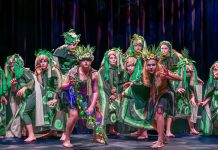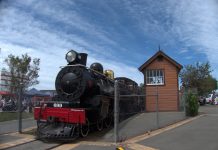

The Boys, the Old Mill, The Kor-Tels, Union Blues Soul Band and The Falcons are just some of the many names synonymous with the Timaru music scene. In this series, reporter Connor Haley talks to Timaru music historian Lyall Smillie and others about the people and places that made up the golden age of Timaru live music. This week’s edition focuses on the legendary Scottish Hall.
Before the disco days and late-night clubbing scene there was one spot Timaruvians flocked to in the hundreds for their weekly dose of musical entertainment.
The Timaru Scottish Society first began holding weekly Saturday night dances in 1924 under the endorsement of the society’s great chief J. Kinloch.
For the initial years functions were held at the Unitarian Hall in Church St but with large attendances the space was quickly deemed too restrictive.
On April 1, 1929, the society officially opened the Scottish Hall, a large concert hall-style venue capable of seating 600 people.
It was was designed by local architect Walter Panton & Sons and built by Andrew Kennedy at 20 Barnard St for the approximate cost of £4000.

The new hall quickly became the place to be for the next several decades.
Synonymous with the Scottish Hall dances was Ron Archie’s Orchestra, originally formed for the 1959 Timaru Centennial Celebration.
Bruce Whitfield, the hall’s resident vocalist, had fond memories of performing with the orchestra.
‘‘I entered into the Ron Archie Orchestra’s Scottish Hall dance music orbit around 1965.
‘‘I’m not sure exactly how, but at the time both Una Stenning and Lester Melhopt were both providing vocals for the band.
‘‘I arrived, armed with such numbers as Hello Dolly, Sweet Georgia Brown, September in the Rain, and of course my two favourites, The Lady is a Tramp, and Lover, Come Back to Me.
‘‘Ron ran a tight ship with his crew and in fact it was quite a unique operation for a band in Timaru, at the time.
‘‘He obtained the orchestra scores from the United Kingdom, with the various band members all receiving their own individual instrumental music lines.’’

He said it was a very fun period of time.
‘‘I was learning professional singing from a German lady — Miss Shaumman in Timaru — singing choral pieces in the local Temuka Presbyterian Church Choir and coming home on a Sunday morning from church to play some loud jazz in the house, before mum and dad arrived home.
‘‘The Timaru Scottish Society, back in the day, was definitely Scottish, staunch and a tightly-run organisation. The treasurer was in attendance at every Saturday dance night to pick up the door takings and then pay Ron and whoever the vocalist was on the night.
‘‘For me, it wasn’t the money, just a great chance to enjoy singing with the band.
‘‘The dances were truly a regular social event on the Timaru city calendar. Well before rock hit the town, the Scottish Hall Saturday night dances were the place to be seen in, a go-to event.’’

Timaru music historian Lyall Smillie said the Scottish Hall was a formative venue for many local musicians, including himself.
‘‘My band, the Muke-E-Tars, played there for a couple of years on and off in the half-hour supper slots and it was good to go there because when you’re starting out as a band you probably only have about 10 songs.
‘‘We’d play that half-hour and we got paid £1.80 each. I was an apprentice joiner then and was on just under £5 a week, so it was good money. A lot of young bands that went on to become popular Timaru guitar groups started there.
‘‘It was an amazing time, the atmosphere was great, the suppers were legendary and they would be getting 300-400 people there a night.
‘‘It’s how a lot of people met and many found their partners for life there too.’’
As the 1970s rolled around attendance slowed and the last regular Saturday night dance took place in 1974.
A newspaper article from March 29, 1974 cited extended drinking hours, lowering of the drinking age to 20 and the introduction of television as some of the reasons the dances were halted and attendance decreased.
The hall is still in regular use by the Scottish Society as well as the wider community as a venue for plays, musicals and all types of stage shows and performances.




